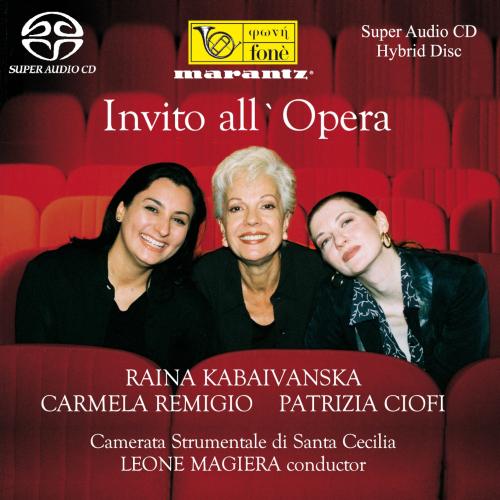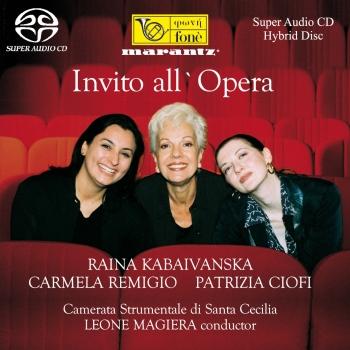
Invito all'Opera Camerata Strumentale di Santa Cecilia & Leone Magiera
Album Info
Album Veröffentlichung:
2001
HRA-Veröffentlichung:
12.03.2021
Label: fonè Records
Genre: Classical
Subgenre: Vocal
Interpret: Camerata Strumentale di Santa Cecilia & Leone Magiera
Das Album enthält Albumcover Booklet (PDF)
- Pietro Mascagni (1863 - 1945):
- 1 Mascagni: Intermezzo - da Cavalleria Rusticana 03:30
- Gioacchino Rossini (1792 - 1868):
- 2 Rossini: Una voce poco fa - da Il Barbiere di Siviglia 06:34
- Giacomo Puccini (1858 - 1924):
- 3 Puccini: O mio babbino caro - da Gianni Schicchi 02:23
- 4 Puccini: In quelle trine morbide - da Manon Lescaut 03:00
- Giuseppe Verdi (1813 - 1901):
- 5 Verdi: Caro nome - da Rigoletto 05:23
- Giacomo Puccini:
- 6 Puccini: Si, mi chiamano Mimì - da La Boheme 05:06
- Giuseppe Verdi:
- 7 Verdi: Pace, pace mio Dio - da La forza del destino 05:48
- Gaetano Donizetti (1797 - 1848):
- 8 Donizzetti: Al dolce guidami - da Anna Bolena 09:13
- Giacomo Puccini:
- 9 Puccini: Che tua madre - da Madama Butterfly 03:34
- 10 Puccini: Walzer di Musetta - da La Boheme 02:41
- 11 Puccini: Tu, che di gel sei cinta - da Turandot 02:52
- 12 Puccini: Vissi d'arte - da Tosca 03:34
- Giuseppe Verdi:
- 13 Verdi: è starno! è strano! - da La Traviata 07:03
- 14 Verdi: Mercè dilette amiche - da I Vespri Siciliani 03:58
- Francesco Cilea (1866 - 1950):
- 15 Cilea: Io son l'umile ancella - da Adriana Lecouvreur 03:37
- Giacomo Puccini:
- 16 Puccini: La canzone di Doretta - da La Rondine 02:09
Info zu Invito all'Opera
Our concert is a collection of a rich variety of styles, representing the vast diversity of human nature depicted in Italian Opera at its peak.
One basic feature, which determines the difference between fonè and other record companies, is the recording of performances in their natural spaces, that is in the places where they were originally presented. This leads to a constant search for suitable locations, and the choice of churches, theatres, country mansions, drawing rooms and so on.
The recordings are carried out with the utmost simplicity, the only way not to do violence to the music: all the equipment is high fidelity; use is made of valve-type paired microphones manufactured in the years 1947 and 1949 (U47, U48 and M49) with an extremely natural and transparent timbre and a bi-microphonic field effect; these microphones have a very important history: they were used to record the Beatles at the Abbey Road Studio and by the RCA for the "Living Stereo" recordings.
Extracted from booklet notes… The Italian Opera stage has always been the realm of the Prima Donna: whether capricious and impetuous, or tender but wretched, whether lapin into the arms of Desiny or hiding behind the solitude of her sentiments, she was the epitome of the nineteenth century, where the daily repression of sentiments produced a contrastino effect in the Arts with a celebration of emotion and free expression…
This album was recorded by Giulio Cesare Ricci at "Auditorium Via della Conciliazione" in Roma on September 1999.
The concert is dominated by a performer who has a remarkable talent for "portrayal in song" and has always used musical notes to construct real, breathing and living human beings: Raina Kabaivanska.
Here she is joined by Patrizia Ciofi and Carmela Remigio, two sopranos united in their belief in the continuity of tradition and in the survival, no matter how rapidly our life style is changing today, of that great revealer of the human soul which is Italian opera.
Accompanying the singers, another pillar of musical tradition: Leone Magiera.
For this recording Giulio Cesare Ricci used the original tube microphones Neumann U47, M49 and all its equipment: advanced mike pre-amplifiers Nagra, analog tape recorders Nagra 4s, line, digital, microphone and supply cables Signoricci.
Also for this recording Giulio Cesare Ricci used a "field effect" recording technique, natural sound, without the use of equalizers, no sound expansion and compression systems ... all this to make the listener live in his own system domestic hifi the live effect as if he was present at the performances.
An album not to be missed!
Raina Kabaivanska, soprano
Carmela Remigio, soprano
Patrizia Ciofi, soprano
Camerata Strumentale di S.Cecilia
Leone Magiera, conductor
Raina Kabaivanska
was born in the Black Sea resort of Burgas. Her father was the founder of Balkantourist, the Bulgarian Tourist Association, and her mother a professor of physics. Kabaivanska studied at the Sofia Conservatory, where for her graduation examination she sang Tatyana’s ‘Letter Scene’ from Eugene Onegin and the final scene of Un ballo in maschera. She also appeared as a soloist with the Workers’ Army Collective and as a member of the chorus of the National Opera.
Having been awarded a government scholarship in 1958, Kabaivanska used this to study with the verismo soprano Zita Fumagalli Riva in Italy and made her solo operatic stage debut in 1959 at Vercelli as Giorgetta / Il tabarro. She sang Mimì / La Bohème and Nedda / Pagliacci in a number of opera houses in Northern Italy before winning a competition to study at the School for Young Opera Singers at La Scala, Milan. Here she worked with Antonio Tonini and Gianandrea Gavazzeni, making her debut at the Piccola Scala in 1961 in Malipiero’s Torneo notturno and appearing at La Scala itself during the same year as Agnese / Beatrice di Tenda, opposite Joan Sutherland.
In 1962 Kabaivanska was invited to sing Desdemona / Otello at the Royal Opera House, London opposite Mario del Monaco, conducted by Georg Solti. The same year she also appeared at the San Francisco Opera and was then contracted by the Metropolitan Opera, New York, where she made her debut in the autumn of 1962 as Nedda. Later roles which she took at the Met included Mimì (1963), Elisabetta / Don Carlo (1963), Alice / Falstaff (1964), Leonora / La forza del destino (1964), Manon / Manon Lescaut (1965), Cio-Cio-San / Madama Butterfly (1967), Maddalena / Andrea Chénier (1970), Marguerite / Faust (1971), Lisa / The Queen of Spades (1972) and, her final role at the Met, Tatyana in 1979. In America Kabaivanska also sang in Chicago, Dallas, Houston, Washington and New Orleans, while continuing her association with La Scala. Here she appeared in a repertoire that included Falstaff, Busoni’s Turandot, Suor Angelica, Don Carlo, Mefistofele and Rienzi (conducted by Hermann Scherchen, 1964). As Elvira / Ernani she opened the 1969–1970 Scala season opposite Placido Domingo. At this time Kabaivanska also met her future husband, an assistant producer. Together they settled in Modena.
From 1971 a permanent guest at the Hamburg State Opera, Kabaivanska made her debut at the Paris Opera in 1975 as Leonora and during the 1970s became a noted interpreter of such heroines of the verismo repertoire as La Wally (Catalani), Francesca da Rimini (Zandonai), Adriana Lecouvreur (Cilea) and Tosca (Puccini). She sang Elena / I vespri siciliani in Maria Callas’s only stage production, at Turin in 1973, as well as Amelia / Simon Boccanegra with Abbado at La Scala in 1976 and Leonora / Il trovatore with Karajan at Salzburg and Vienna during 1978. Later she sang Alice with Karajan at Salzburg and on film in 1981 and 1982.
Following Tosca opposite Pavarotti at La Scala in 1980 Kabaivanska sued the theatre for breach of contract and her career was subsequently focused upon the other major Italian houses: Rome, Bologna, Naples, Turin and Palermo. In Rome she sang opposite Alfredo Kraus as Massenet’s Manon in 1981, going on to open the 1981–1982 season in Donizetti’s Fausta. This move into more Classical roles was followed by Spontini’s La vestale at Genoa and Gluck’s Armida at Bologna (both during 1984) and Elisabetta in Donizetti’s Roberto Devereux in Rome (1988) and Genoa (1993). At the Verona Arena she sang Butterfly in 1978, 1983 and 1997.
Kabaivanska began to give master-classes in 1992 and was closely associated with the Accademia Chigiana at Siena. Still remarkably active in the opera house, from 1993 onwards she appeared in several major twentieth-century roles, such as the Countess / Capriccio, the Abandoned Woman / La voix humaine, the Governess / The Turn of the Screw, Emilia Marty / The Makropoulos Case and the Kostelnička / Jenůfa, as well as Lehár’s Die lustige Witwe and Weill’s Lady in the Dark.
The distinguished Italian writer and coach Rodolfo Celletti has aptly described Kabaivanska’s voice thus: ‘It is a voice that becomes different each time’, while she herself has credited her success, especially with the Italian public, to her power to ‘live’ on the stage.
Booklet für Invito all'Opera











